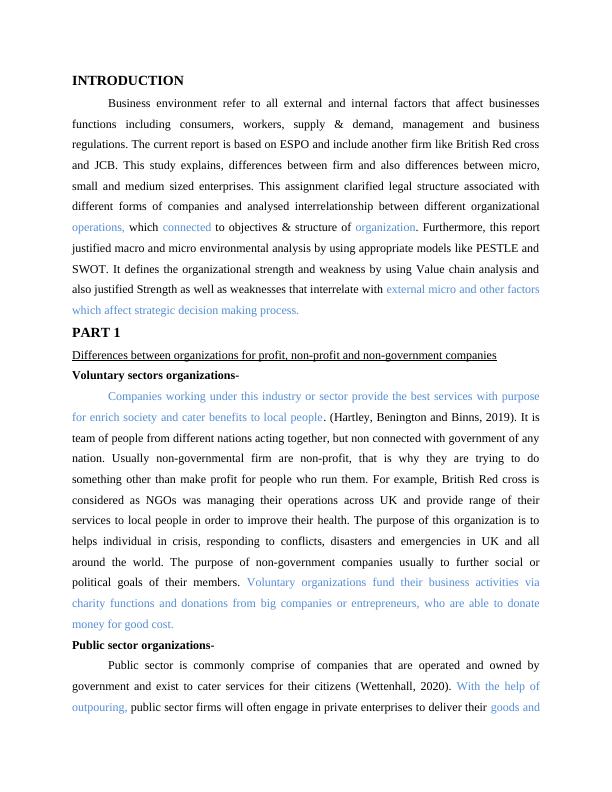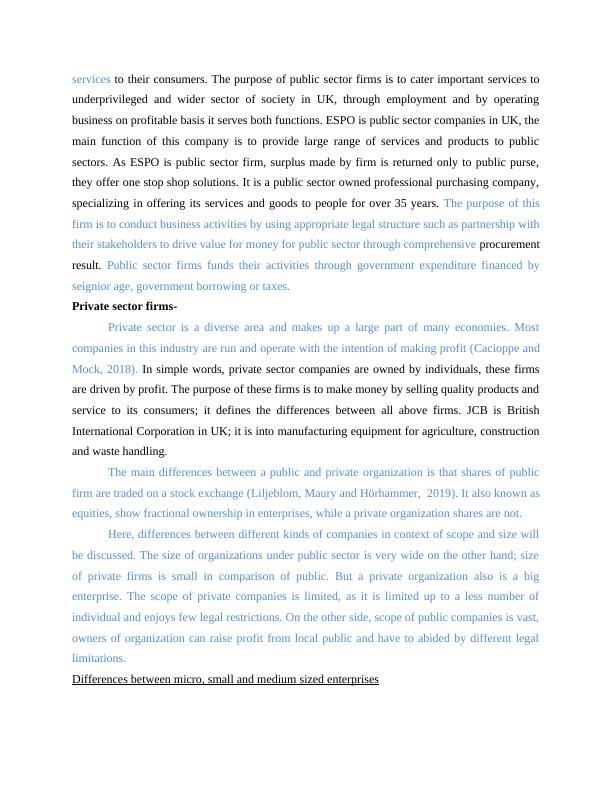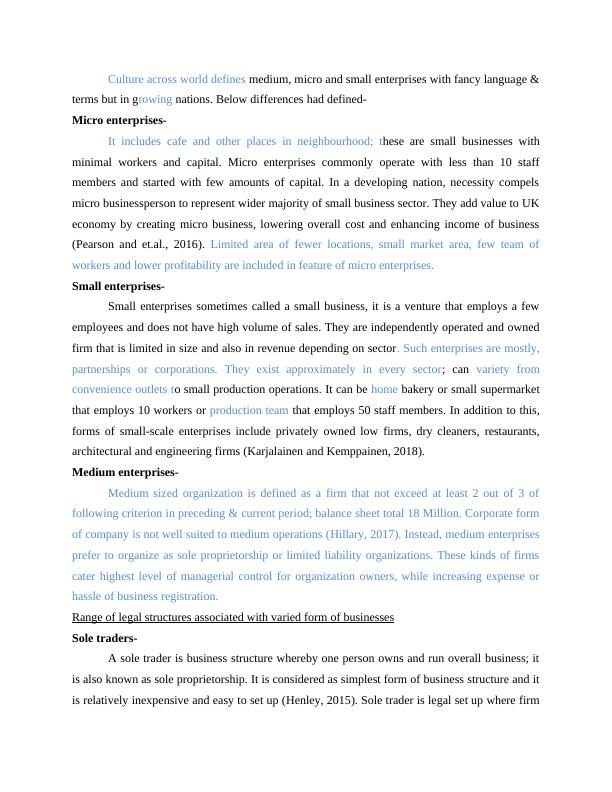Differences between Organizations for Profit, Non-Profit and Non-Government Companies
Added on 2023-01-13
23 Pages6935 Words80 Views
BUSINESS AND BUSINESS
ENVIRONMENT
ENVIRONMENT

Table of Contents
Table of Contents.............................................................................................................................2
INTRODUCTION...........................................................................................................................3
PART 1............................................................................................................................................3
Differences between organizations for profit, non-profit and non-government companies........3
Differences between micro, small and medium sized enterprises...............................................4
Range of legal structures associated with varied form of businesses..........................................5
Legal structure, size and scope of various firm link to business objectives, services and
products........................................................................................................................................6
Interrelationships of different organizational functions and their connection to organizational
objectives and structure...............................................................................................................8
PART 2..........................................................................................................................................10
Macro environment analysis using PESTEL framework..........................................................10
Micro environment analysis using Porter's five forces model...................................................12
Value chain analysis to identify organization's internal strength & weakness..........................14
SWOT analysis..........................................................................................................................16
Strength and weakness interrelated with external micro and macro factors, that influence
strategic business decision making............................................................................................17
CONCLUSION..............................................................................................................................17
REFERENCES..............................................................................................................................18
Table of Contents.............................................................................................................................2
INTRODUCTION...........................................................................................................................3
PART 1............................................................................................................................................3
Differences between organizations for profit, non-profit and non-government companies........3
Differences between micro, small and medium sized enterprises...............................................4
Range of legal structures associated with varied form of businesses..........................................5
Legal structure, size and scope of various firm link to business objectives, services and
products........................................................................................................................................6
Interrelationships of different organizational functions and their connection to organizational
objectives and structure...............................................................................................................8
PART 2..........................................................................................................................................10
Macro environment analysis using PESTEL framework..........................................................10
Micro environment analysis using Porter's five forces model...................................................12
Value chain analysis to identify organization's internal strength & weakness..........................14
SWOT analysis..........................................................................................................................16
Strength and weakness interrelated with external micro and macro factors, that influence
strategic business decision making............................................................................................17
CONCLUSION..............................................................................................................................17
REFERENCES..............................................................................................................................18


INTRODUCTION
Business environment refer to all external and internal factors that affect businesses
functions including consumers, workers, supply & demand, management and business
regulations. The current report is based on ESPO and include another firm like British Red cross
and JCB. This study explains, differences between firm and also differences between micro,
small and medium sized enterprises. This assignment clarified legal structure associated with
different forms of companies and analysed interrelationship between different organizational
operations, which connected to objectives & structure of organization. Furthermore, this report
justified macro and micro environmental analysis by using appropriate models like PESTLE and
SWOT. It defines the organizational strength and weakness by using Value chain analysis and
also justified Strength as well as weaknesses that interrelate with external micro and other factors
which affect strategic decision making process.
PART 1
Differences between organizations for profit, non-profit and non-government companies
Voluntary sectors organizations-
Companies working under this industry or sector provide the best services with purpose
for enrich society and cater benefits to local people. (Hartley, Benington and Binns, 2019). It is
team of people from different nations acting together, but non connected with government of any
nation. Usually non-governmental firm are non-profit, that is why they are trying to do
something other than make profit for people who run them. For example, British Red cross is
considered as NGOs was managing their operations across UK and provide range of their
services to local people in order to improve their health. The purpose of this organization is to
helps individual in crisis, responding to conflicts, disasters and emergencies in UK and all
around the world. The purpose of non-government companies usually to further social or
political goals of their members. Voluntary organizations fund their business activities via
charity functions and donations from big companies or entrepreneurs, who are able to donate
money for good cost.
Public sector organizations-
Public sector is commonly comprise of companies that are operated and owned by
government and exist to cater services for their citizens (Wettenhall, 2020). With the help of
outpouring, public sector firms will often engage in private enterprises to deliver their goods and
Business environment refer to all external and internal factors that affect businesses
functions including consumers, workers, supply & demand, management and business
regulations. The current report is based on ESPO and include another firm like British Red cross
and JCB. This study explains, differences between firm and also differences between micro,
small and medium sized enterprises. This assignment clarified legal structure associated with
different forms of companies and analysed interrelationship between different organizational
operations, which connected to objectives & structure of organization. Furthermore, this report
justified macro and micro environmental analysis by using appropriate models like PESTLE and
SWOT. It defines the organizational strength and weakness by using Value chain analysis and
also justified Strength as well as weaknesses that interrelate with external micro and other factors
which affect strategic decision making process.
PART 1
Differences between organizations for profit, non-profit and non-government companies
Voluntary sectors organizations-
Companies working under this industry or sector provide the best services with purpose
for enrich society and cater benefits to local people. (Hartley, Benington and Binns, 2019). It is
team of people from different nations acting together, but non connected with government of any
nation. Usually non-governmental firm are non-profit, that is why they are trying to do
something other than make profit for people who run them. For example, British Red cross is
considered as NGOs was managing their operations across UK and provide range of their
services to local people in order to improve their health. The purpose of this organization is to
helps individual in crisis, responding to conflicts, disasters and emergencies in UK and all
around the world. The purpose of non-government companies usually to further social or
political goals of their members. Voluntary organizations fund their business activities via
charity functions and donations from big companies or entrepreneurs, who are able to donate
money for good cost.
Public sector organizations-
Public sector is commonly comprise of companies that are operated and owned by
government and exist to cater services for their citizens (Wettenhall, 2020). With the help of
outpouring, public sector firms will often engage in private enterprises to deliver their goods and

services to their consumers. The purpose of public sector firms is to cater important services to
underprivileged and wider sector of society in UK, through employment and by operating
business on profitable basis it serves both functions. ESPO is public sector companies in UK, the
main function of this company is to provide large range of services and products to public
sectors. As ESPO is public sector firm, surplus made by firm is returned only to public purse,
they offer one stop shop solutions. It is a public sector owned professional purchasing company,
specializing in offering its services and goods to people for over 35 years. The purpose of this
firm is to conduct business activities by using appropriate legal structure such as partnership with
their stakeholders to drive value for money for public sector through comprehensive procurement
result. Public sector firms funds their activities through government expenditure financed by
seignior age, government borrowing or taxes.
Private sector firms-
Private sector is a diverse area and makes up a large part of many economies. Most
companies in this industry are run and operate with the intention of making profit (Cacioppe and
Mock, 2018). In simple words, private sector companies are owned by individuals, these firms
are driven by profit. The purpose of these firms is to make money by selling quality products and
service to its consumers; it defines the differences between all above firms. JCB is British
International Corporation in UK; it is into manufacturing equipment for agriculture, construction
and waste handling.
The main differences between a public and private organization is that shares of public
firm are traded on a stock exchange (Liljeblom, Maury and Hörhammer, 2019). It also known as
equities, show fractional ownership in enterprises, while a private organization shares are not.
Here, differences between different kinds of companies in context of scope and size will
be discussed. The size of organizations under public sector is very wide on the other hand; size
of private firms is small in comparison of public. But a private organization also is a big
enterprise. The scope of private companies is limited, as it is limited up to a less number of
individual and enjoys few legal restrictions. On the other side, scope of public companies is vast,
owners of organization can raise profit from local public and have to abided by different legal
limitations.
Differences between micro, small and medium sized enterprises
underprivileged and wider sector of society in UK, through employment and by operating
business on profitable basis it serves both functions. ESPO is public sector companies in UK, the
main function of this company is to provide large range of services and products to public
sectors. As ESPO is public sector firm, surplus made by firm is returned only to public purse,
they offer one stop shop solutions. It is a public sector owned professional purchasing company,
specializing in offering its services and goods to people for over 35 years. The purpose of this
firm is to conduct business activities by using appropriate legal structure such as partnership with
their stakeholders to drive value for money for public sector through comprehensive procurement
result. Public sector firms funds their activities through government expenditure financed by
seignior age, government borrowing or taxes.
Private sector firms-
Private sector is a diverse area and makes up a large part of many economies. Most
companies in this industry are run and operate with the intention of making profit (Cacioppe and
Mock, 2018). In simple words, private sector companies are owned by individuals, these firms
are driven by profit. The purpose of these firms is to make money by selling quality products and
service to its consumers; it defines the differences between all above firms. JCB is British
International Corporation in UK; it is into manufacturing equipment for agriculture, construction
and waste handling.
The main differences between a public and private organization is that shares of public
firm are traded on a stock exchange (Liljeblom, Maury and Hörhammer, 2019). It also known as
equities, show fractional ownership in enterprises, while a private organization shares are not.
Here, differences between different kinds of companies in context of scope and size will
be discussed. The size of organizations under public sector is very wide on the other hand; size
of private firms is small in comparison of public. But a private organization also is a big
enterprise. The scope of private companies is limited, as it is limited up to a less number of
individual and enjoys few legal restrictions. On the other side, scope of public companies is vast,
owners of organization can raise profit from local public and have to abided by different legal
limitations.
Differences between micro, small and medium sized enterprises

Culture across world defines medium, micro and small enterprises with fancy language &
terms but in growing nations. Below differences had defined-
Micro enterprises-
It includes cafe and other places in neighbourhood; these are small businesses with
minimal workers and capital. Micro enterprises commonly operate with less than 10 staff
members and started with few amounts of capital. In a developing nation, necessity compels
micro businessperson to represent wider majority of small business sector. They add value to UK
economy by creating micro business, lowering overall cost and enhancing income of business
(Pearson and et.al., 2016). Limited area of fewer locations, small market area, few team of
workers and lower profitability are included in feature of micro enterprises.
Small enterprises-
Small enterprises sometimes called a small business, it is a venture that employs a few
employees and does not have high volume of sales. They are independently operated and owned
firm that is limited in size and also in revenue depending on sector. Such enterprises are mostly,
partnerships or corporations. They exist approximately in every sector; can variety from
convenience outlets to small production operations. It can be home bakery or small supermarket
that employs 10 workers or production team that employs 50 staff members. In addition to this,
forms of small-scale enterprises include privately owned low firms, dry cleaners, restaurants,
architectural and engineering firms (Karjalainen and Kemppainen, 2018).
Medium enterprises-
Medium sized organization is defined as a firm that not exceed at least 2 out of 3 of
following criterion in preceding & current period; balance sheet total 18 Million. Corporate form
of company is not well suited to medium operations (Hillary, 2017). Instead, medium enterprises
prefer to organize as sole proprietorship or limited liability organizations. These kinds of firms
cater highest level of managerial control for organization owners, while increasing expense or
hassle of business registration.
Range of legal structures associated with varied form of businesses
Sole traders-
A sole trader is business structure whereby one person owns and run overall business; it
is also known as sole proprietorship. It is considered as simplest form of business structure and it
is relatively inexpensive and easy to set up (Henley, 2015). Sole trader is legal set up where firm
terms but in growing nations. Below differences had defined-
Micro enterprises-
It includes cafe and other places in neighbourhood; these are small businesses with
minimal workers and capital. Micro enterprises commonly operate with less than 10 staff
members and started with few amounts of capital. In a developing nation, necessity compels
micro businessperson to represent wider majority of small business sector. They add value to UK
economy by creating micro business, lowering overall cost and enhancing income of business
(Pearson and et.al., 2016). Limited area of fewer locations, small market area, few team of
workers and lower profitability are included in feature of micro enterprises.
Small enterprises-
Small enterprises sometimes called a small business, it is a venture that employs a few
employees and does not have high volume of sales. They are independently operated and owned
firm that is limited in size and also in revenue depending on sector. Such enterprises are mostly,
partnerships or corporations. They exist approximately in every sector; can variety from
convenience outlets to small production operations. It can be home bakery or small supermarket
that employs 10 workers or production team that employs 50 staff members. In addition to this,
forms of small-scale enterprises include privately owned low firms, dry cleaners, restaurants,
architectural and engineering firms (Karjalainen and Kemppainen, 2018).
Medium enterprises-
Medium sized organization is defined as a firm that not exceed at least 2 out of 3 of
following criterion in preceding & current period; balance sheet total 18 Million. Corporate form
of company is not well suited to medium operations (Hillary, 2017). Instead, medium enterprises
prefer to organize as sole proprietorship or limited liability organizations. These kinds of firms
cater highest level of managerial control for organization owners, while increasing expense or
hassle of business registration.
Range of legal structures associated with varied form of businesses
Sole traders-
A sole trader is business structure whereby one person owns and run overall business; it
is also known as sole proprietorship. It is considered as simplest form of business structure and it
is relatively inexpensive and easy to set up (Henley, 2015). Sole trader is legal set up where firm

End of preview
Want to access all the pages? Upload your documents or become a member.
Related Documents
Differences between Non-Profit, Profit, and Non-Government Organizationslg...
|18
|6004
|58
Differences between companies for non-government, profit and non-profit firmslg...
|15
|4322
|71
Different Types and Purpose of Organisation in Business Environmentlg...
|18
|6014
|76
Types and Purpose of Organisations - Public, Private and Voluntary Sectors and Legal Structureslg...
|17
|5435
|49
Differences between profit and non-profit organizations, micro, small, and medium-sized enterprises, and interrelationships of organizational functionslg...
|14
|4816
|46
Difference between Organizational Forms and Interrelationship between Operationslg...
|17
|4991
|89
